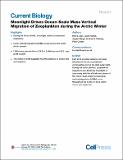Files in this item
Moonlight drives ocean-scale mass vertical migration of zooplankton during the Arctic winter
Item metadata
| dc.contributor.author | Last, Kim S. | |
| dc.contributor.author | Hobbs, Laura | |
| dc.contributor.author | Berge, Jørgen | |
| dc.contributor.author | Brierley, Andrew Stuart | |
| dc.contributor.author | Cottier, Finlo | |
| dc.date.accessioned | 2016-02-02T15:10:09Z | |
| dc.date.available | 2016-02-02T15:10:09Z | |
| dc.date.issued | 2016-01-25 | |
| dc.identifier | 240750336 | |
| dc.identifier | 9a091e58-a006-41d8-a499-3d9327cafdfd | |
| dc.identifier | 84959538916 | |
| dc.identifier | 000368972300028 | |
| dc.identifier.citation | Last , K S , Hobbs , L , Berge , J , Brierley , A S & Cottier , F 2016 , ' Moonlight drives ocean-scale mass vertical migration of zooplankton during the Arctic winter ' , Current Biology , vol. 26 , no. 2 , pp. 244-251 . https://doi.org/10.1016/j.cub.2015.11.038 | en |
| dc.identifier.issn | 0960-9822 | |
| dc.identifier.other | ORCID: /0000-0002-6438-6892/work/60427327 | |
| dc.identifier.uri | https://hdl.handle.net/10023/8116 | |
| dc.description | The creation of the pan-Arctic archive of ADCP data was supported by the UK Natural Environment Research Council (NERC) (Panarchive: NE/H012524/1 and SOFI: NE/F012381/1) as was mooring work in Svalbard (Oceans 2025 and Northern Sea Program). Moorings were also supported by the Research Council of Norway (NFR) projects: Circa (214271), Cleopatra (178766), Cleopatra II (216537), and Marine Night (226471). | en |
| dc.description.abstract | In extreme high-latitude marine environments that are without solar illumination in winter, light-mediated patterns of biological migration have historically been considered non-existent [1]. However, diel vertical migration (DVM) of zooplankton has been shown to occur even during the darkest part of the polar night, when illumination levels are exceptionally low [2 and 3]. This paradox is, as yet, unexplained. Here, we present evidence of an unexpected uniform behavior across the entire Arctic, in fjord, shelf, slope and open sea, where vertical migrations of zooplankton are driven by lunar illumination. A shift from solar-day (24-hr period) to lunar-day (24.8-hr period) vertical migration takes place in winter when the moon rises above the horizon. Further, mass sinking of zooplankton from the surface waters and accumulation at a depth of ∼50 m occurs every 29.5 days in winter, coincident with the periods of full moon. Moonlight may enable predation of zooplankton by carnivorous zooplankters, fish, and birds now known to feed during the polar night [4]. Although primary production is almost nil at this time, lunar vertical migration (LVM) may facilitate monthly pulses of carbon remineralization, as they occur continuously in illuminated mesopelagic systems [5], due to community respiration of carnivorous and detritivorous zooplankton. The extent of LVM during the winter suggests that the behavior is highly conserved and adaptive and therefore needs to be considered as “baseline” zooplankton activity in a changing Arctic ocean [6, 7, 8 and 9]. | |
| dc.format.extent | 8 | |
| dc.format.extent | 1717658 | |
| dc.language.iso | eng | |
| dc.relation.ispartof | Current Biology | en |
| dc.subject | GC Oceanography | en |
| dc.subject | QH301 Biology | en |
| dc.subject | BDC | en |
| dc.subject | R2C | en |
| dc.subject | SDG 14 - Life Below Water | en |
| dc.subject.lcc | GC | en |
| dc.subject.lcc | QH301 | en |
| dc.title | Moonlight drives ocean-scale mass vertical migration of zooplankton during the Arctic winter | en |
| dc.type | Journal article | en |
| dc.contributor.sponsor | NERC | en |
| dc.contributor.institution | University of St Andrews. School of Biology | en |
| dc.contributor.institution | University of St Andrews. Marine Alliance for Science & Technology Scotland | en |
| dc.contributor.institution | University of St Andrews. Scottish Oceans Institute | en |
| dc.contributor.institution | University of St Andrews. Centre for Research into Ecological & Environmental Modelling | en |
| dc.contributor.institution | University of St Andrews. Pelagic Ecology Research Group | en |
| dc.identifier.doi | 10.1016/j.cub.2015.11.038 | |
| dc.description.status | Peer reviewed | en |
| dc.identifier.grantnumber | NE/F012381/1 | en |
This item appears in the following Collection(s)
Items in the St Andrews Research Repository are protected by copyright, with all rights reserved, unless otherwise indicated.

